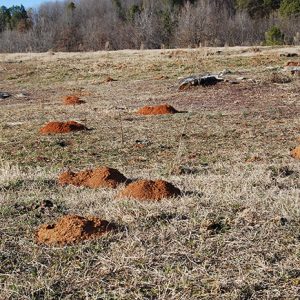calsfoundation@cals.org
Ozark Pocket Gopher
aka: Geomys bursarius ozarkensis
The Ozark pocket gopher is a small mammal that belongs to the family Geomyidae (pocket gophers) and the order Rodentia (rodents). It is endemic to Arkansas, occurring in Izard County. The common name “pocket gopher” comes from the fur-lined cheek pouches that these animals use to carry food.
Two species of pocket gophers live in Arkansas. Geomys bursarius can be found from southern Manitoba southward through the central plains of the United States toward Arkansas and Texas, with the subspecies G. b. ozarkensis found in the southwestern one-third of Izard County in Arkansas. Although a few individuals have been captured on the southern side of the White River in adjacent Stone County, no current population resides in any other county besides Izard.
The Ozark pocket gopher is considered by the Arkansas Game and Fish Commission to be a “species of special concern” in Arkansas due to its restricted distribution and separation from other subspecies. The closest related subspecies, G. bursarius missouriensis, lives in southeastern Missouri, near St. Louis.
The Ozark pocket gopher spends the majority of its life underground in burrows, typically in fields, such as cattle and hay pastures. It is an herbivore, eating plant roots and stalks. Pocket gophers live in solitary burrows and are aggressive toward each other.
The gophers are restricted to the low-lying areas adjacent to rivers and streams mainly within the floodplain. The soil found there, which is high in sand content and low in clay and rocks, is good for underground burrowing, unlike the more common rocky ground of the Ozark Plateau found within Izard County. Pocket gophers mound up excess dirt on the surface of the ground while constructing and maintaining their burrows. Ozark pocket gophers are rarely seen above ground, so it is uncommon to catch a glimpse of one, yet dirt mounds are evidence of their activity.
The burrows consist of long series of foraging tunnels (10–30 centimeters or 4–12 inches deep) and typically deeper nest and latrine areas. The nests are usually about 30–60 centimeters (1–2 feet) below the ground and consist of finely shredded grass. The underground burrows provide an ecosystem that many invertebrates rely on. Specifically, in Ozark pocket gopher burrows, cave crickets can be found primarily in the foraging tunnels, and anthomyiid flies, rove beetles, hister beetles, and scarab beetles live in the nest and latrine chambers, where they rely on the dung of the pocket gophers, or other invertebrates utilizing this dung, for a food source.
Many species of vertebrates—including amphibians, reptiles, and small mammals—also use the habitat provided by the pocket gophers for functions such as foraging and refuge. Although these burrows are used by many other species of animals, farmers consider pocket gophers agricultural pests due to the mounds of dirt they build and tunnels they create under the surface of the pastures.
For additional information:
Connior, Matthew B. “Home Range, Dispersal, and Survival of the Ozark Pocket Gopher.” MS thesis, Arkansas State University, 2008.
Connior, Matthew B., and Thomas S. Risch. “Home Range and Survival of the Ozark Pocket Gopher (Geomys bursarius ozarkensis) in Arkansas.” American Midland Naturalist 164, no. 1 (2010): 80–90.
Kershen, Audrey Allbach. “Density, Distribution and Habitat Requirements for the Ozark Pocket Gopher (Geomys bursarius ozarkensis).” MS thesis, University of North Texas, 2004.
Robison, H., C. McAllister, C. Carlton, and G. Tucker. “The Arkansas Endemic Biota: An Update with Additions and Deletions.” Journal of the Arkansas Academy of Science 62 (2008): 84–96. Online at http://libinfo.uark.edu/aas/issues/2008v62/v62a12.pdf (accessed November 5, 2014).
Sealander, J. A., and G. A. Heidt. Arkansas Mammals: Their Natural History, Classification, and Distribution. Fayetteville: University of Arkansas Press, 1990.
Matthew B. Connior
South Arkansas Community College
 Ozark Pocket Gopher
Ozark Pocket Gopher  Pocket Gopher Mounds
Pocket Gopher Mounds  Pocket Gopher Newborn
Pocket Gopher Newborn 




Comments
No comments on this entry yet.